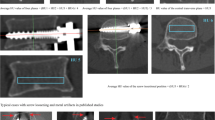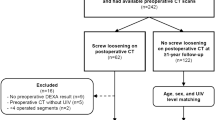Abstract
Background
The sufficiency of screw anchoring is a critical factor for achieving successful spinal fusion; however, no reliable method for predicting pedicle screw fixation has been established. Recently, Hounsfield units (HU) obtained from computed tomography (CT) was developed as a new reliable tool to determine the bone quality. The purpose of the present study was to demonstrate the utility of regional HU measurement of the screw trajectory to predict the primary and long-term fixation strength of pedicle screws.
Method
The insertional torque of pedicle screws using the cortical bone trajectory technique was measured intraoperatively in 92 consecutive patients who underwent single-level posterior lumbar interbody fusion. The cylindrical area of each screw was plotted on the preoperative CT image by precisely confirming the screw position, and the screw trajectory was measured in HU. First, three parameters: the bone mineral density (BMD) of the femoral neck and lumbar vertebrae, and regional HU values of the screw trajectory, were correlated with the insertional torque and compared among three groups. Next, pedicle screw loosening was evaluated by postoperative CT obtained 12 months after surgery, and clinical and imaging data were analyzed to assess whether regional HU values could be used as a predictor of screw loosening.
Results
Regional HU values of the screw trajectory (r = 0.75, p < 0.001) had stronger correlation with the insertional torque than the femoral BMD (r = 0.59, p < 0.001) and lumbar BMD (r = 0.55, p < 0.001). The incidence of screw loosening was 4.6% (16/351). Multivariate logistic regression analysis revealed that regional HU value (odds ratio = 0.70; 95% confidence interval = 0.56-0.84; p = 0.018) was an independent risk factor significantly affected screw loosening.
Conclusions
Regional HU values of the screw trajectory could be a strong predictor of both primary and long-term screw fixation in vivo.





Similar content being viewed by others
References
Aichmair A, Moser M, Bauer MR, Bachmann E, Snedeker JG, Betz M, Farshad M (2017) Pull-out strength of patient-specific template-guided vs. free-hand fluoroscopically controlled thoracolumbar pedicle screws: a biomechanical analysis of a randomized cadaveric study. Eur Spine J 26:2865–2872
Brantley AG, Mayfield JK, Koeneman JB, Clark KR (1994) The effects of pedicle screw fit: an in vitro study. Spine (Phila Pa 1976) 19:1752–1758
Bredow J, Boese CK, Werner CML, Siewe J, Löhrer L, Zarghooni K, Eysel P, Scheyerer MJ (2016) Predictive validity of preoperative CT scans and the risk of pedicle screw loosening in spine surgery. Arch Orthop Trauma Surg 136:1063–1067
Bühler DW, Berlemann U, Oxland TR, Nolte LP (1998) Moments and forces during pedicle screw insertion: in vitro and in vivo measurements. Spine (Phila Pa 1976) 23:1220–1228
Cho W, Cho SK, Wu C (2010) The biomechanics of pedicle screw-based instrumentation. J Bone Joint Surg (Br) 92:1061–1065
Coe JD, Warden KE, Herzig MA, McAfee PC (1990) Influence of bone mineral density on the fixation of thoracolumbar implants: a comparative study of transpedicular screws, laminar hooks, and spinous process wires. Spine (Phila Pa 1976) 15:902–907
DeWald CJ, Stanley T (2006) Instrumentation-related complications of multilevel fusions for adult deformity patients over age 65: surgical considerations and treatment options in patients with poor bone quality. Spine (Phila Pa 1976) 31:S144–S151
Halvorson TL, Kelly LA, Thomas KA, Whitecloud TS, Cook SD (1994) Effects of bone mineral density on pedicle screw fixation. Spine (Phila Pa 1976) 19:2415–2420
Hu SS (1997) Internal fixation in the osteoporotic spine. Spine (Phila Pa 1976) 22:S43–S48
Kim JB, Park SW, Lee YS, Nam TK, Park YS, Kim YB (2015) The effects of spinopelvic parameters and paraspinal muscle degeneration on S1 screw loosening. J Korean Neurosurg Soc 58:357–362
Law M, Tencer AF, Anderson PA (1993) Caudo-cephalad loading of pedicle screws: biomechanisms of loosening and methods of augmentation. Spine (Phila Pa 1976) 18:2438–2443
Lee JH, J-H LE, Park JW, Shin YH (2012) The insertional torque of a pedicle screw has a positive correlation with bone mineral density in posterior lumbar pedicle screw fixation. J Bone Joint Surg (Br) 94:93–97
Matsukawa K, Taguchi E, Yato Y, Imabayashi H, Hosogane N, Asazuma T, Nemoto K (2015) Evaluation of the fixation strength of pedicle screws using cortical bone trajectory: what is the ideal trajectory for optimal fixation? Spine (Phila Pa 1976) 40:E873–E878
Matsukawa K, Yato Y, Hynes RA, Imabayashi H, Hosogane N, Yoshihara Y, Asazuma T, Nemoto K (2017) Comparison of pedicle screw fixation strength among different transpedicular trajectories: a finite element study. Clin Spine Surg 30:301–307
Matsukawa K, Yato Y, Imabayashi H, Hosogane N, Abe Y, Asazuma T, Chiba K (2016) Biomechanical evaluation of fixation strength among different sizes of pedicle screws using the cortical bone trajectory: what is the ideal screw size for optimal fixation? Acta Neurochir 158:465–471
Matsukawa K, Yato Y, Kato T, Imabayashi H, Asazuma T, Nemoto K (2014) In vivo analysis of insertional torque during pedicle screwing using cortical bone trajectory technique. Spine (Phila Pa 1976) 39:E240–E245
Meredith DS, Schreiber JJ, Taher F, Cammisa FP Jr, Girardi FP (2013) Lower preoperative Hounsfield unit measurements are associated with adjacent segment fracture after spinal fusion. Spine (Phila Pa 1976) 38:415–418
Mi J, Li K, Zhao X, Zhao CQ, Li H, Zhao J (2017) Vertebral body Hounsfield units are associated with cage subsidence after transforaminal lumbar interbody fusion with unilateral pedicle screw fixation. Clin Spine Surg 30:E1130–E1136
Myers BS, Belmont PJ, Richardson WJ, Yu JR, Harper KD, Nightingale RW (1996) The role of imaging and in situ biomechanical testing in assessing pedicle screw pull-out strength. Spine (Phila Pa 1976) 21:1962–1968
Schreiber JJ, Anderson PA, Rosas HG, Buchholz AL, Au AG (2011) Hounsfield units for assessing bone mineral density and strength: a tool for osteoporosis management. J Bone Joint Surg Am 93:1057–1063
Schreiber JJ, Hughes AP, Taher F, Girardi FP (2014) An association can be found between Hounsfield units and success of lumbar spine fusion. HSS J 10:25–29
Turkyilmaz I, Sennerby L, McGlumphy EA, Tözüm TF (2009) Biomechanical aspects of primary implant stability: a human cadaver study. Clin Implant Dent Relat Res 11:113–119
Turkyilmaz I, Tumer C, Ozbek EN, Tözüm TF (2007) Relations between the bone density values from computed tomography, and implant stability parameters: a clinical study of 230 regular platform implants. J Clin Periodontol 34:716–722
Yamagata M, Kitahara H, Minami S, Takahashi K, Isobe K, Moriya H, Tamaki T (1992) Mechanical stability of the pedicle screw fixation systems for the lumbar spine. Spine (Phila Pa 1976) 17:S51–S54
Zdeblick TA, Kunz DN, Cooke ME, McCabe R (1993) Pedicle screw pullout strength: correlation with insertional torque. Spine (Phila Pa 1976) 18:1673–1676
Acknowledgements
We thank Akio Seitoku for helpful advice on measuring HU.
Funding
No funds were received in support of this work. No benefits in any form have been or will be received from a commercial party related directly or indirectly to the subject of this manuscript.
Author information
Authors and Affiliations
Corresponding author
Ethics declarations
Conflict of interest
None.
Ethical approval
All procedures performed in studies involving human participants were in accordance with the ethical standards of our institutional (National Hospital Organization, Murayama Medical Center) and with the 1964 Helsinki declaration and its later amendments or comparable ethical standards.
Informed consent
Informed consent was obtained from all individual participants included in the study.
Rights and permissions
About this article
Cite this article
Matsukawa, K., Abe, Y., Yanai, Y. et al. Regional Hounsfield unit measurement of screw trajectory for predicting pedicle screw fixation using cortical bone trajectory: a retrospective cohort study. Acta Neurochir 160, 405–411 (2018). https://doi.org/10.1007/s00701-017-3424-5
Received:
Accepted:
Published:
Issue Date:
DOI: https://doi.org/10.1007/s00701-017-3424-5




